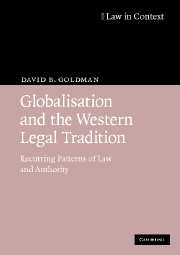Book contents
- Frontmatter
- Contents
- Preface
- 1 Introduction
- Part 1 Towards a Globalist Jurisprudence
- Part 2 A Holy Roman Empire
- Part 3 State Formation and Reformation
- Part 4 A Wholly Mammon Empire?
- Part 5 Competing Jurisdictions Case Studies
- 11 The twenty-first century European community
- 12 International commercial law and private governance
- 13 Conclusion: what is to be done?
- Bibliography
- Index
13 - Conclusion: what is to be done?
Published online by Cambridge University Press: 30 March 2010
- Frontmatter
- Contents
- Preface
- 1 Introduction
- Part 1 Towards a Globalist Jurisprudence
- Part 2 A Holy Roman Empire
- Part 3 State Formation and Reformation
- Part 4 A Wholly Mammon Empire?
- Part 5 Competing Jurisdictions Case Studies
- 11 The twenty-first century European community
- 12 International commercial law and private governance
- 13 Conclusion: what is to be done?
- Bibliography
- Index
Summary
A human being is part of the whole called by us ‘universe’, a part limited in time and space. We experience ourselves, our thoughts and feelings as something separate from the rest. A kind of optical delusion of consciousness. This delusion is a kind of prison for us, restricting us to our personal desires and to affection for a few persons nearest to us. Our task must be to free ourselves from the prison by widening our circle of compassion to embrace all living creatures and the whole of nature in its beauty. … We shall require a substantially new manner of thinking if mankind is to survive.
Albert EinsteinAlbert Einstein discovered the relativity of time and space in the midst of the World Revolution. History may one day show that these scientific symbols were necessary for the emergence of human consciousness of globalisation as we know it (just as Newtonian science accompanied the displacement of divine monarchical government by parliamentary government in seventeenth-century England). Globalisation in a novel way demonstrates the universalist dimensions of the local and the particular, and the diverse particular, local impacts of universalist norms. Natural manifestations of space (such as continent or hemisphere) and time (such as day and night) for the first time in human history can no longer stop events in one part of the world from having almost instantaneous implications in another part. Single events may give rise to a variety of interpretations and ramifications across a multiplicity of communities.
‘September 11’ is a highly relevant demonstration of this global interconnection, as we have already noted.
- Type
- Chapter
- Information
- Globalisation and the Western Legal TraditionRecurring Patterns of Law and Authority, pp. 296 - 316Publisher: Cambridge University PressPrint publication year: 2008



